A Look Back at On Pettaquamscutt Presentations
2012
2013
2014
2015
2016
2017
2018
2019 The Shortened 2020 Season Back to the Present
Season One, 2012
It was the inaugural season and three wonderful presenters drew near-capacity crowds, demonstrating interest in the watershed and the library's critical role in life of the community.
January: Veronica Berounsky, Ph.D., Chair, Rhode Island Rivers Council and Vice President, Narrow River Preservation Association presented a virtual tour of Narrow River – Past and Present.
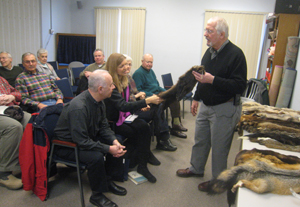 February: Mike Lapisky, former Chief of the Division of Fish and Wildlife, R.I. Department of Environmental Management, brought in a collection of pelts and told us all about Wildlife at Canonchet Farm.
February: Mike Lapisky, former Chief of the Division of Fish and Wildlife, R.I. Department of Environmental Management, brought in a collection of pelts and told us all about Wildlife at Canonchet Farm.
March: Jim Crothers, Executive Director, South County Museum, claimed that all his stories about Canonchet The People and The Place were "true, and some actually happened." (back to top)
No Sophomore Slump, 2013
In year two the series continued to attract large audiences, as speakers explored a mix of topics about life in the Narrow River Watershed.
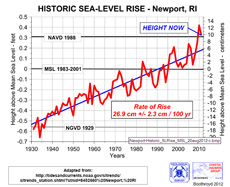 January: The late Jon Boothroyd, Ph.D., URI Research Professor Emeritus and Narrow River Preservation Association Vice President - Science, packed the house for his talk on Climate Change, Coastal Geologic Hazards and Sea Level Rise: Some R.I. Strategies.
January: The late Jon Boothroyd, Ph.D., URI Research Professor Emeritus and Narrow River Preservation Association Vice President - Science, packed the house for his talk on Climate Change, Coastal Geologic Hazards and Sea Level Rise: Some R.I. Strategies.
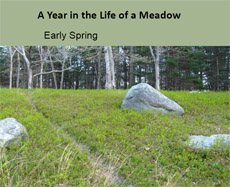 February:
We moved from coastal storms to the calm of Blue-Flag Iris and Heart-Leaved Groundsel when Hope Leeson of the Rode Island Natural History Survey told us about The Rhody Plant Initiative, which promotes use of native plants grown from local seeds.
February:
We moved from coastal storms to the calm of Blue-Flag Iris and Heart-Leaved Groundsel when Hope Leeson of the Rode Island Natural History Survey told us about The Rhody Plant Initiative, which promotes use of native plants grown from local seeds.
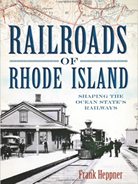 March: When Frank Heppner, Ph.D. retired from teaching biology at URI he gave full play to his passionate interest in railroads (including the museum at the Kingston Station). Frank told us about Short Line and Electric Railroads of R.I., including the SeaView Railroad, which ran along Narrow River at the turn of the 20th Century.
March: When Frank Heppner, Ph.D. retired from teaching biology at URI he gave full play to his passionate interest in railroads (including the museum at the Kingston Station). Frank told us about Short Line and Electric Railroads of R.I., including the SeaView Railroad, which ran along Narrow River at the turn of the 20th Century.
 Things were a might bit easier in our second year because we were assisted by Intern Extraordinaire Ben Rauh, then a Junior at Narragansett High School, who helped set up computers and microphones, checked guests in and generally keep things under control. Ben would help us again in 2014, but then we lost him to the University of Utah, where he is studying management theory (and the art of skiing). (back to top)
Things were a might bit easier in our second year because we were assisted by Intern Extraordinaire Ben Rauh, then a Junior at Narragansett High School, who helped set up computers and microphones, checked guests in and generally keep things under control. Ben would help us again in 2014, but then we lost him to the University of Utah, where he is studying management theory (and the art of skiing). (back to top)
Third Season's a Charm, 2014
In Season Three we learned about a famous resident at the north end of the river, the critters that inhabit the southern end and efforts to improve the diversity of plant life along the coastal ponds.
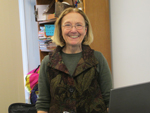 January: Peggy O’Connor started off the season with The Red House at the Head of Narrow River: Birthplace of Gilbert Stuart, Painter of Presidents. Peg is Director of the Gilbert Stuart Birthplace and Museum.
January: Peggy O’Connor started off the season with The Red House at the Head of Narrow River: Birthplace of Gilbert Stuart, Painter of Presidents. Peg is Director of the Gilbert Stuart Birthplace and Museum.
February: David Gregg, Ph.D., Executive Director of the Rhode Island Natural History Survey, reported on the BioBlitz at the South County Museum in June 2013, showed what the professional and amateur scientists found in their 24-hour search of Canonchet Farm and Pettaquamscutt Cove, and recounted how they survived the heaviest rainfall of the summer. Biodiversity is Everywhere: 1,200 Species of Life: And 4.5 Inches of Rain in the Narragansett BioBlitz.
March: Kathie Kelleher and David Smith, members of the Friends of Canonchet Farm Habitat Restoration Committee, explained the work of volunteers removing invasive vegetation from the edge of the coastal ponds across from the Narragansett Town Beach. Take a look at Restoring Habitat at Lake Canonchet. (back to top)
Dealing with Coyotes, Colonists and Climate Change in 2015
The Fourth Season proved once again that the Narrow River River Watershed is a dynamic environment offer an array of topics about changes old and new.
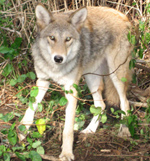 January: Coyotes, originally a prairie species, have colonized the Continental U.S. over the last 100 years, and in the mid-1990s even took up residence in South County and on the islands in Narragansett Bay. For the January presentation, Numi Mitchell, lead scientist in the Narragansett Bay Coyote Study, described the most successful practices for managing coyote herds. Learn more about the Narragansett Bay Coyote Study.
January: Coyotes, originally a prairie species, have colonized the Continental U.S. over the last 100 years, and in the mid-1990s even took up residence in South County and on the islands in Narragansett Bay. For the January presentation, Numi Mitchell, lead scientist in the Narragansett Bay Coyote Study, described the most successful practices for managing coyote herds. Learn more about the Narragansett Bay Coyote Study.
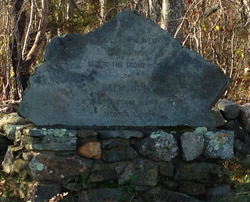 February: “A few rods from this spot stood the Stone House of Jireh Bull Burned by the Indians December 15, 1675,” so reads the stone marker on Middlebridge Road commemorating a preemptive strike by the Narragansetts to prevent Bull’s fortification from being used by Connecticut and Massachusetts Bay militia assembling to attack the tribe. In February, anthropologist Colin Porter told us the story behind the stone and what Jireh Bull’s Garrison House meant to Native Americans and Europeans struggling to coexist in the Narragansett Country.
February: “A few rods from this spot stood the Stone House of Jireh Bull Burned by the Indians December 15, 1675,” so reads the stone marker on Middlebridge Road commemorating a preemptive strike by the Narragansetts to prevent Bull’s fortification from being used by Connecticut and Massachusetts Bay militia assembling to attack the tribe. In February, anthropologist Colin Porter told us the story behind the stone and what Jireh Bull’s Garrison House meant to Native Americans and Europeans struggling to coexist in the Narragansett Country.
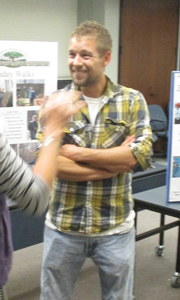
 March: Wenley Ferguson, Director of Habitat Restoration at Save The Bay, described Save the Bay's efforts at Salt Marsh Restoration Across the State and in Narrow River. She was joined by Nick Ernst of U.S. Fish & Wildlife Service, who described restoration techniques then being considered for Narrow River. For an update on marsh restoration in the watershed, visit the Chafee Wildlife Refuge page at www.fws.gov.
March: Wenley Ferguson, Director of Habitat Restoration at Save The Bay, described Save the Bay's efforts at Salt Marsh Restoration Across the State and in Narrow River. She was joined by Nick Ernst of U.S. Fish & Wildlife Service, who described restoration techniques then being considered for Narrow River. For an update on marsh restoration in the watershed, visit the Chafee Wildlife Refuge page at www.fws.gov.
Looking Back and Ahead in 2016
In Season Five we looked back to Colonial Era plantation life and to pre-contact agricultural practices, and two biologists asked: Can we go back to the future?
 2016 Presenters: Jeffrey Greene, Laura Myerson, Rick Enser and Jay Waller
2016 Presenters: Jeffrey Greene, Laura Myerson, Rick Enser and Jay Waller
January: Furniture maker Jeffrey Greene, author of American Furniture of the 18th Century: History, Technique, Structure, described Furnishing the South County Plantation Homes. Visit the Jeffrey Greene Newport website to see his work.
February: Laura Myerson, Professor of Habitat Restoration Ecology in the Department of Natural Resources Sciences at URI, and ecosystem biologist Richard Enser, asked "Can We Go Back to the Future?" as they explored What Does Restoration Mean in the Age of Global Change.
March: Archaeologist Jay Waller wrapped up the series with What R110 Tells us about the Native American Usage of the Natural Resources at Canonchet Farm. R110 is an archaeological site that rests on the upper portion of Salt Pond just south of Commodore Perry Highway (U.S. 1) and which is arguably the most significant pre-European contact Native American find on the East Coast.
2017 Preserving the Environment
In our sixth season, we took a look at things hidden in plain sight: the gradual rise of the water level, the ancient creatures that inhabit Canonchet Farm and structures from the river's industrial past.
 2017 Presenters: Jennifer Wihite, Craig Swanson, Nancy Karraker and Tim Cranston
2017 Presenters: Jennifer Wihite, Craig Swanson, Nancy Karraker and Tim Cranston
January: It was full house at the Maury Loontjens Memorial Library when we began the 2017 series with updates on two projects for Improving the Health of the Narrow River Estuary in Narrow River:
 Dr. Jennifer White, Hurricane Sandy Resiliency Coordinator for the U.S. Fish & Wildlife Service, described a restoration project in the John H. Chafee National Wildlife Reserve to raise the elevation of saltmarshes so that plants can thrive. See photos of the saltmarsh grass planting and other restoration work in Narrow River.
Dr. Jennifer White, Hurricane Sandy Resiliency Coordinator for the U.S. Fish & Wildlife Service, described a restoration project in the John H. Chafee National Wildlife Reserve to raise the elevation of saltmarshes so that plants can thrive. See photos of the saltmarsh grass planting and other restoration work in Narrow River.
 Dr. Craig Swanson of Swanson Environmental Associates discussed the impact of proposed dredging at the mouth of Narrow River to increase circulation within the estuary.
Dr. Craig Swanson of Swanson Environmental Associates discussed the impact of proposed dredging at the mouth of Narrow River to increase circulation within the estuary.
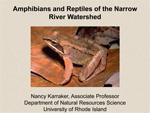 February: Dr. Nancy Karraker, URI Associate Professor in the Department of Natural Resources Science, described Amphibians and Reptiles in the Narrow River Watershed, including those that are threatened from the impacts of habitat loss, pollution, climate change, invasive species and disease.
February: Dr. Nancy Karraker, URI Associate Professor in the Department of Natural Resources Science, described Amphibians and Reptiles in the Narrow River Watershed, including those that are threatened from the impacts of habitat loss, pollution, climate change, invasive species and disease.
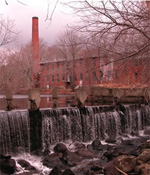 March: Local historian, preservation advocate and columnist Tim Cranston took us on a virtual tour of the north end of the watershed and told us about Industry along the Pettaquamscutt with Native American fishing and agricultural practice and then on to the historic mills at Silver Spring, Shady Lea and Gilbert Stuart. (back to top)
March: Local historian, preservation advocate and columnist Tim Cranston took us on a virtual tour of the north end of the watershed and told us about Industry along the Pettaquamscutt with Native American fishing and agricultural practice and then on to the historic mills at Silver Spring, Shady Lea and Gilbert Stuart. (back to top)
2018 The Power of Stitches, Bees and Data
In our seventh season (yes, seventh season!), we saw the handiwork of some very talented teenagers, learned what native bees and other pollinators need to thrive, and heard the good news and not so good news about water quality in the Narrow River Watershed.
 January: South County Museum Associate Director Blaire O. Gagnon started things off with "The Sampler – A Young Lady's Education in the 18th & 19th Centuries." Blaire explained how young girls learned to cross-stitch and demonstrate their proficiency with letters, numbers and even poetry with traditional "samplers." Blaire brought several 200 year old examples of the art work, as did Peggy O'Connor from the holdings at the Gilbert Stuart Birthplace and Museum.
January: South County Museum Associate Director Blaire O. Gagnon started things off with "The Sampler – A Young Lady's Education in the 18th & 19th Centuries." Blaire explained how young girls learned to cross-stitch and demonstrate their proficiency with letters, numbers and even poetry with traditional "samplers." Blaire brought several 200 year old examples of the art work, as did Peggy O'Connor from the holdings at the Gilbert Stuart Birthplace and Museum.
Visit the Sampler Archive for more information on samplers, including examples from the Rhode Island Historical Society collection. See also the Sampler Consortium.
Read Phil Cozzolino's review in the January 31 Narragansett Times.
 February: Gary Casabona, the R.I. State Biologist for the USDA Natural Resources Conservation Services, presented “Habitat Management for Pollinators.” Casabona talked about the importance of planting a wide variety of species that support wildlife to ensure that there are pollen and nectar resources available for all seasons. Download a pamphlet describing the work of NRCS with the Xerces Society to protect native pollinators.
February: Gary Casabona, the R.I. State Biologist for the USDA Natural Resources Conservation Services, presented “Habitat Management for Pollinators.” Casabona talked about the importance of planting a wide variety of species that support wildlife to ensure that there are pollen and nectar resources available for all seasons. Download a pamphlet describing the work of NRCS with the Xerces Society to protect native pollinators.
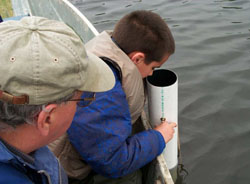 March: URI Watershed Watch Program Director Linda Green explained the work of some 250 volunteer monitors who test water in the lakes, river and estuaries throughout Rhode Island, and then focused on conditions and trends in Narrow River based on 25 years of testing by the NRPA River Watch program.
March: URI Watershed Watch Program Director Linda Green explained the work of some 250 volunteer monitors who test water in the lakes, river and estuaries throughout Rhode Island, and then focused on conditions and trends in Narrow River based on 25 years of testing by the NRPA River Watch program.
View Linda's slide presentation.
Read Phil Cozzolino's review in the March 28 Narragansett Times. (back to top)
2019 Then, Now and Next On Three Historic Farms
The eighth season featured three historic farms in the watershed: Canonchet Farm in Narragansett, Casey Farm in Saunderstown and Shadow Farm in Wakefield. We learned about their history, preservation and plans.
 January: The Friends of Canonchet Farm is funding design of a linear park along the two coastal ponds across from Narragansett Town Beach. Landscape Architect Randy Collins of Beta Group presented the plans for an inviting and sustainable landscape in the heart of Narragansett. View Randy Collins PowerPoint presentation.
January: The Friends of Canonchet Farm is funding design of a linear park along the two coastal ponds across from Narragansett Town Beach. Landscape Architect Randy Collins of Beta Group presented the plans for an inviting and sustainable landscape in the heart of Narragansett. View Randy Collins PowerPoint presentation.
 February: Resident and local historian David Chidakel traced the ownership of Shadow Farm from the Colonial times of the Robinsons and Hazards to its development as a condominium project in the 1980s. View the presentation on YouTube.
February: Resident and local historian David Chidakel traced the ownership of Shadow Farm from the Colonial times of the Robinsons and Hazards to its development as a condominium project in the 1980s. View the presentation on YouTube.
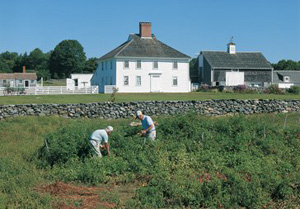 March: Silas Casey's Farm sits on a 300-acre plot laid out as part of the Namcook Purchase in 1659, extending across Boston Neck from Narrow River to Narragansett Bay. In "Waves of Blue, Waves of Green: The Southern R.I. Farms of Historic New England," Jane Hennedy, Southern Rhode Island Site Manager at Historic New England, traced centuries of changes to the land and compared Casey Farm to its sister, Watson Farm across the West Passage in Jamestown. Their shared mission of historic preservation, landscape conservation, producing local food, and innovative educational programs comes through when following the seasonal rhythms of the farms in pictures and stories. For more views and information visit HistoricNewEngland.org.
March: Silas Casey's Farm sits on a 300-acre plot laid out as part of the Namcook Purchase in 1659, extending across Boston Neck from Narrow River to Narragansett Bay. In "Waves of Blue, Waves of Green: The Southern R.I. Farms of Historic New England," Jane Hennedy, Southern Rhode Island Site Manager at Historic New England, traced centuries of changes to the land and compared Casey Farm to its sister, Watson Farm across the West Passage in Jamestown. Their shared mission of historic preservation, landscape conservation, producing local food, and innovative educational programs comes through when following the seasonal rhythms of the farms in pictures and stories. For more views and information visit HistoricNewEngland.org.
For more information: Call 401 783-5344, or E-mail dsmithmark@cox.net.
Copyright. Rosemary and David Smith, 2012-2025. Revised August 8, 2022.